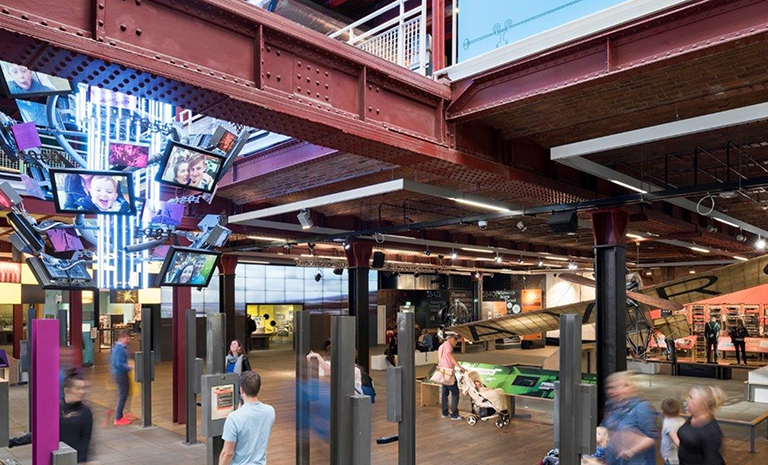Arts and Culture
BI and Analytics
Business Strategy
Digital
Technology
Article
Insights & Innovation
25fed4af-02db-4c7f-8ce4-7768053d4c61
5 min
https://edge.sitecorecloud.io/tessiturane75c3-tessituraneee12-development-6640/media/Images/Licensee-Photography/Photos_768x465/smg_transf_768x465.jpg?h=465&iar=0&w=768
How one museum brings digital transformation to life
Putting it together

Chief Innovation Officer, Tessitura
Putting it together
5/23/2023
5 min
Digital transformation can seem like something everyone discusses but no one defines.
My goal is to make the subject real for you. I have provided a practical definition, debunked common myths, summarized relevant technology and explored audience connections. I’ve shown how digital transformation can drive value for arts and culture organizations.
But what does digital transformation look like in practice? Let’s dive into a real-world example. Here’s a museum doing an excellent job of putting the principles of digital transformation to work.
What does digital transformation look like in practice? Science Museum Group puts these principles to work.
Making digital transformation real at Science Museum Group
Science Museum Group (SMG) is a collection of five venues in the United Kingdom, with locations in London, Bradford, Manchester, York and County Durham. They focus on the history of science, technology, engineering and medicine.
In 2019, the museums collectively welcomed 5.2 million visitors. Guests did not need admissions tickets to enter. They could book some on-site activities in advance, either online or by phone. Upon arrival, a team member would welcome each visitor and ask if they wanted to make a donation.

Prior to the introduction of free timed ticketing, Science Museum Group captured data on only 7% of their annual visitors.
In total, SMG captured about 700,000 orders, with 52% connected to a named constituent. That meant the museums collected data on only 7% of their annual visitors.
In March 2020, the museums joined the rest of the world in closing their doors due to the global pandemic. They reopened that August. But the government mandated that venues collect contact information for all visitors. At SMG, this required a swift transition from an open-door model to one of free museum ticketing.
Principles of digital transformation at work
We’ve shared elements of the SMG story before. This time, I’d like to look at their efforts through the lens of digital transformation.
1. They started with strategy.
The SMG team completely reimagined their customer journey to introduce timed ticketing. They started by establishing customer relationship management as the backbone to their work. The journey came first. Then they mapped the online reservation path. Since visitors now booked free tickets in advance, SMG could also ask for donations and upsell other activities. They increased not only the average order value but also the donation-per-head.
2. They centered their visitors.
Staff at the museums knew they wanted to rank visitor experience first in all decisions. They collected feedback to learn where visitors encountered friction. Then they used that data to adjust processes they’d already rolled out. In the end, they improved visitor experience by spreading attendance throughout the day. They sent pre-visit communications that helped guests better understand what to expect. Because they showcased activities best booked in advance, more guests learned about experiences they otherwise might have missed.
3. They involved everyone.
SMG didn’t relegate digital transformation work to a few staff. The museums empowered teams to be experimental, cross-departmental and collaborative.
4. They prioritized learning and embraced agility.
Teams didn’t assume they’d get everything right at launch. Rather, they were intentional about testing and learning. They embraced experimenting, iterating and improving processes as they learned what worked. They tried several methods for ticket delivery and adjusted admission intervals over time. They even used alternate approaches at different sites to learn faster.
Science Museum Group empowered teams to be experimental, cross-departmental and collaborative.
5. They employed technology to power evolution.
SMG adopted Tessitura as its CRM and transactional platform in 2016. Until then, they used different ticketing, email and fundraising systems at different museum sites. There was little opportunity to share insights or transfer knowledge. With a common platform, they were more agile and could move quickly when faced with disruption.
6. They used data to drive efficiencies.
The team recognized an opportunity to gather and use data in new ways. They tracked no-shows and over-allocations. Access to contact details meant they could measure visitor sentiment through anonymized post-attendance surveys. They adjusted the customer journey to analyze how small changes impacted donation metrics. Catering and retail teams used attendance data and add-on purchase information to better predict staffing needs.
7. They leveraged digital convenience.
SMG encouraged guests to place lunch orders in advance to avoid queues. Increases in mailing list sign-ups allowed the team to send more follow-up communications and personalize them.
By applying digital transformation principles, Science Museum Group delivered considerable value to visitors.
Today, a learning mindset permeates SMG. The team continues to conduct new experiments. Recognizing that ticketing can be a barrier to some visitors, they seek opportunities to streamline processes. They center their guests at each step.
By applying digital transformation principles, SMG delivered considerable value to visitors. At the same time, they increased internal efficiencies. And, by knowing who their visitors are, SMG built more engaging relationships with them.
Topics
Arts & Culture
/BI & Analytics
/Business Strategy
/Digital
/Technology

Beyond the buzz
Arts & Culture / BI & Analytics / Business Strategy / Digital / Technology
What I wish someone had told me about digital transformation

Debunking four digital transformation myths
Arts & Culture / BI & Analytics / Business Strategy / Digital / Technology
Setting the record straight about common misconceptions

Propelling innovation
Arts & Culture / BI & Analytics / Business Strategy / Digital / Technology
Three technology advances driving digital transformation in arts and culture
